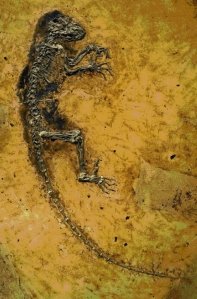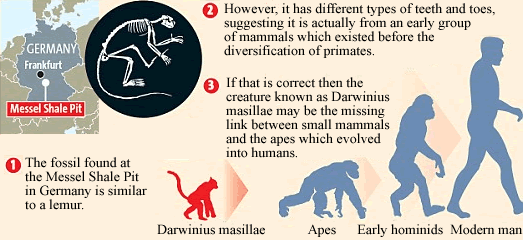The Darwinius masillae / Ida fossil
as the link to uncovering our earliest ancestors

.gif)
|
Was Ida / Darwinius masillae one of our earliest ancestors?
Fig. 1A of the PLoS ONE article about the Ida fossil, published under the Creative Commons Attribution License;
any reuse should cite the authors and journal.
Full citation details here
|
|
After two years of secretive preparation full details of the project that became the Darwinius masillae / Ida fossil study
were given at a fanfare launch at the
academically prestigious American Museum of Natural History on Tuesday, May 19, 2009, arrangements also having been
put in place for an associated TV special, entitled " Uncovering our earliest ancestor : The Link ",
to be rolled out world-wide.
Also announced were an associated book, entitled "The Link", and a high-powered web site.
It became clear that the Darwinius masillae / Ida fossil had been under expert scientific scrutiny for
some two years after having been purchased by the University of Oslo from a private fossil collector. During those
two years, although rumours of the discovery of a spectacular primate fossil were circulating amongst
specialists in the field, the general public was not informed of these developments.
Against this background of secrecy the Darwinius masillae / Ida fossil study
was given an impressively high-power PR launch. A few days prior to the actual launch date press releases
about it were issued on behalf of the organisers. All in uppercase some of the press releases read:-
"MEDIA ALERT," - "WORLD-RENOWNED SCIENTISTS REVEAL A REVOLUTIONARY SCIENTIFIC FIND THAT WILL
CHANGE EVERYTHING."
At the launch presentation itself ambitious words were used such as the "Missing Link to
our Earliest Ancestors" and the "Rosetta Stone of Human Evolution".
Comparisons of cultural importance
were made with the Mona Lisa and to the Moon Landings.
How far is all this hype justified? Will the study of the Darwinius masillae / Ida fossil provide
sufficiently far-reaching results in the way of uncovering our earliest ancestors, and their places on the
primate family tree, to justify Ida being
referred to simply, and in just so many words, as - The Link?
The project apparently had its origins in December, 2006, at a mineral and fossil fair in
Hamburg where Dr. Hurum got into conversation with a private fossil dealer named Thomas Perner
who was already known to him and who,
over fruity vodka drinks, showed him a few photographs of the fossil, which had been found at Messel
Shale Pit in 1983 and had subsequently
been hanging on the wall in the house of a German collector.
Herr Perner discreetly advised Dr. Hurum that the fossil had already been quietly "on the market" for some
six months at an asking price of, wait for it, more than $1,000,000.
It seems that at least two prominent German museums had already been approached, possibly with the same
or similar photographs,
but had baulked at this asking price for a fossil that they had not found to be of proven merit.
A certain amount of forgery, fakery, and interpretative reconstruction, is known to go on
in the fossil-collecting world so participants in the fossil market need to be both knowledgeable and careful.
Dr. Hurum, a fossil expert, was so excited by what he saw in these pictures, ("I knew that the dealer had a world sensation in
his hands"),
that he reportedly
“could not sleep for two nights, just thinking about this specimen.”
Back home in Norway Dr. Hurum reported
news of this extra-ordinary fossil and its equally extra-ordinary asking price to his colleagues.
Although Dr. Hurum does not seem to have actually actually expected it funds were found such that he was able to enter into
negotiations leading to the purchase of the fossil.
The Darwinius masillae fossil has been described as the “most complete fossil primate ever
discovered,” lacks only the lower left limb, and due to the special conditions
prevailing at Messel Pit impressions
of Ida's fur and of her soft body outline are discernable - the remains of her last meal - comprising
fruit and leaves - have been detected in the stomach cavity.
![[ida transitional species sketch from fossil evidence ]](ida_sketch.jpg)
.gif)
|
|
This sketched representation of Ida, and her kind, is taken from the
report published by the research team on the Public Library of Science web site.
The image is Fig. S6 of the PLoS ONE article, published under the Creative Commons Attribution License;
any reuse should cite the authors and journal.
Full citation details here
| |
The researches have concluded that this fossil was that of a lemur-like creature that was "not simply a lemur" and that its
discovery "is going to advance our knowledge of evolution".
Darwinius masillae differs from lemurs in two key ways - it does not possess the "toothcomb" set of
lower front teeth lemurs use to groom fur or the "toilet claws" on the hind feet the lemur family tend to use
for scratching leading the researchers to depict it as having been a "Lemur-Monkey".
A bone in Ida's ankle called the talus is shaped like that members of our own, Anthropoid, branch of the
primates. Ida's nail-bearing fingers and toes also confirm her to having been a primate.
It would seem that
this extraordinary fossil “is important in being exceptionally well preserved and providing a much more complete
understanding of the paleobiology” of a primate from the Eocene period. The Greek derived word, Eocene,
actually translates as the "New Dawn", and it is in the Eocene that larger mammals are believed to
have made their first appearance.
Uncovering our earliest ancestors
and the primate family tree

It may be that the Ida - Darwinius masillae fossil will readily become accepted as being
a transitional fossil of an early lemur-monkey from the time, 47 million years ago, when
lemurs and monkeys were diverging as species.
A particularly
important clue to her eventual placing in terms of the primate evolutionary tree may arise from the very completeness of this
fossil if researchers
are ultimately able to discern whether or not this fossil was of a creature that had
a "wet" nose.
Modern primates are divided into two suborders: the strepsirrhines, or “wet-nosed” primates,
include lemurs, bushbabies
and lorises, while the haplorrhines or “dry-nosed” primates include monkeys, apes and humans.
In preparing their report the research team referred to an number of already accepted strepsirrhine
and haplorrhine characteristics and, on that basis, have actually gone so far as to place Ida as clearly tending
towards being a haplorrhine rather than a strepsirrhine.
The researchers believe Ida may be on our own evolutionary line dating from just after the split with the lemurs and
that this fossil is from "a transitional species showing characteristics from both the non-human
(prosimians and lemurs) and human (anthropoids, monkeys, apes and man) evolutionary lines".
To quote the research teams
report, “Darwinius masillae, and adapoids contemporary with early tarsioids, could represent a stem group from
which later anthropoid primates evolved, but we are not advocating this here, nor do we consider either Darwinius
or adapoids to be anthropoids".
Dr. Philip Gingerich, a leading American primate
specialist based at the University of Michigan, president of the American Paleontological Society
and co-author of the Darwinius masillae study, went so far as to state that:-
“This discovery brings a forgotten group into focus as a possible
ancestor of higher primates.”
The Darwinius masillae / Ida fossil has been dated as being from an early primate that lived
all of 47 million years ago.
That is rather a long time back in the past.
Using "mya" as shorthand for "million years ago" the scientist tell us that the primate family tree
enduringly "branched" on several occasions:-
The first primates lived some 55mya from which time the Haplorrhines and the Strepsirrhines were diverging.
Whilst the Strepsirrhine branch ultimately produced today's Lemurs, bushbabys, and Lorises the
the Haplorrhine branch itself re-branched many times.
Resulting from these re-branchings monkeys are dated to 40mya, gibbons to 20mya, gorillas to 8mya,
chimpanzees to 5.4mya and early
hominds to 4mya, the famous "Lucy" fossil to 3.2mya, and modern Homo sapiens to .2mya.
In the context of such a long-lived and deep-rooted primate family tree it is perhaps justified to
suspect that there could be future uncoverings of other, even more relevant, fossils.
A close colleague of, and indeed, collaborator and co-author with, Drs. Gingerich and Hurum on the two-year study of the Ida fossil, Jens Franzen, of the Forschungsinstitut Senckenberg, Frankfurt,
Germany, which has an overseeing role for the Messel Shale Pit World Heritage Site, was also at the launch
ceremony and hailed the Darwinius masillae / Ida discovery as "the eighth wonder of the world" but also stated that "we're not dealing with
our grand, grand, grandmother, but perhaps with our grand, grand, grand aunt" and that "she belongs to the group from which
higher primates and human beings developed but my impression is she is not on the direct line."
Moreover, the closing sentences of the body of the academic study available online are perhaps somewhat restrained in the claims they seem make about
this possible Missing Link fossil discovery.
Morphological characteristics preserved in Darwinius masillae enable a rigorous comparison with the two principal subdivisions of living primates: Strepsirrhini and Haplorhini. Defining characters of Darwinius ally it with early haplorhines rather than strepsirrhines. We do not interpret Darwinius as anthropoid, but the adapoid primates it represents deserve more careful comparison with higher primates than they have received in the past.
Darwinius masillae is important in being exceptionally well preserved and providing a much more complete understanding of the paleobiology of an
Eocene primate than was available in the past.
Full citation details here
Since May 2009 two other serious studies have actually placed Darwinius Masillae on the strepsirrhine
rather than haplorhine evolutionary branch.
For further details please see:-
Other Studies Conclusions

|
|
![[darwinius masillae, ida, uncovering, earliest ancestors, primate family tree]](evolution.gif)
![[darwinius masillae, ida, uncovering, earliest ancestors, primate family tree]](evolution.gif)

